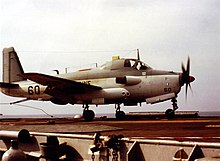Ateliers d'Aviation Louis Breguet
The Société Anonyme des Ateliers d'Aviation Louis Breguet was a French aircraft manufacturer and was founded in Douai in 1911 by Louis Charles Breguet .
Aircraft production
In addition to a number of seaplanes, the company manufactured the powerful Breguet 14 military aircraft at its new location in Villacoublay near Paris from 1916 . More than 7,500 units of this type are built; the Breguet 17 , which was further developed from it, was only produced in smaller numbers after the end of the First World War.
The Breguet 19 , offered from 1922, was produced in more than 2,000 copies from 1924. With a machine of this type called "Breguet Bidon" (with an enlarged tank), Dieudonné Costes and Maurice Bellonte crossed the Atlantic on the Lindbergh route in 1930 .
After aircraft types such as Breguet 27 , Breguet 521 and Breguet 730 , Breguet plants were opened in Le Havre and Nantes . In 1939, as part of its nationalization, Breguet was split into SNCAN and SNCAO , and Latécoère was taken over. Up to the armistice in 1940, 200 Breguet 690 bombers had been delivered.
Starting in 1945, the Breguet 763 Provence was developed as a robust and economical transport aircraft for civil aviation. After their maiden flight in 1949, Air France used twelve of this type on the North Africa and Mediterranean routes from 1953 to 1971.
Breguet took an active part in the development of recreational aviation at the same time as the production of a number of economical, robust and powerful gliders like the Breguet 901 . The 901 became the most successful glider in France.
These technical successes, however, went hand in hand with considerable financial difficulties for the aircraft construction company. When Louis Breguet died in 1955, Sylvain Floirat took over the helm of the company.
Advanced prototypes such as the STOL Breguet 940 Vultur aircraft were developed. It was followed by the Breguet 941 and Breguet 1050 Alizé series .
As a result of participating in a NATO tender for a light tactical fighter aircraft, the company developed the Breguet 1001 Taon , which set a speed record but was ultimately not ordered.
In 1964, the Breguet Atlantic , a maritime patrol aircraft , made its maiden flight. It was a European development that was to be followed by a number of other joint developments.
In 1966, Breguet and the British Aircraft Corporation (BAC) took part in the development program for the SEPECAT Jaguar , followed by collaboration with the German company Dornier as part of the Alpha Jet project .
In 1971 the “Société Anonyme des Ateliers d'Aviation Louis Breguet” was taken over by Avions Marcel Dassault (AMB) , which took the name “Avions Marcel Dassault - Breguet Aviation” (AMDBA).
Automobile production
In 1907 a few cars were built alongside airplanes. There were two models with six-cylinder engines that delivered either 30 hp or 50 hp. In 1942, during the Second World War , electric vehicles were produced due to the petrol shortage . A Paris-Rhône engine mounted in the stern provided the drive. The wheelbase was specified at 198 cm, the top speed at 48 km / h and the range at 104 km. An electric vehicle from 1942 can be seen in the Louwman Collection in The Hague .
See also
literature
- George Nick Georgano (Editor-in-Chief): The Beaulieu Encyclopedia of the Automobile. Volume 1: A – F. Fitzroy Dearborn Publishers, Chicago 2001, ISBN 1-57958-293-1 (English).
- George Nick Georgano: Cars. Encyclopédie complète. 1885 à nos jours. Courtille, Paris 1975 (French).
Individual evidence
- ↑ Breguet 901/901 S1
- ^ A b c Georgano: The Beaulieu Encyclopedia of the Automobile.




